So, is great accounting website design something you actually need? Shouldn’t its content be as dull as an accountant’s work?
Quite the opposite, there’s always a story behind the tedium.
Every time the police arrest someone for a white-collar crime, who plays a huge role in the bust? You guessed it. The accountants who uncovered the number-fudging.
How about the accountant who kept a startup afloat? Here’s how: she found some expenses that the busy owner had forgotten. That accountant kept her client from paying higher taxes.
Accountants aren’t zeroes; they’re heroes. Everyday heroes.
So, great accounting web design needs to showcase the hero in every accounting firm, large or small. It’s time we rethink the accounting profession and its website design.
In this post, we’ll show you examples of some of our favorite accounting website designs. And, we’ll look at some of the “bad and ugly” ones. That way, you’ll know which designs to stay away from.
Benefits of a quality accounting website design
“But why should I make my website fun to read?” you might ask. After all, aren’t people looking for an accountant used to boring websites? Wouldn’t they think us unprofessional if our website was fun to read?
We’re not saying that your website should take on a circus atmosphere. All we’re saying is that your website design should show how you help your clients solve their toughest problems.
People love stories. Your prospects are no different.
Studies show that people remember what they read for weeks afterward if it’s in story form.
When you tell a story about how one of your accountants tracked down a person that stole money from an elderly widow, they’ll remember it. And they’ll want you to do the same thing for them.
A website that tells what you’ve done for your clients will help you connect with your prospects. And, the more they learn about your business, the more they’ll trust you.
In the end, if you build enough trust with great design and content, your visitors will become customers. That’s not the end of the road, though.
The better your website, the more they’ll share your content with their friends. Then, the cycle starts all over again.
Epiic offers professional design services at a one-time price.
Get access to a skilled web designer.
Great accounting website examples
As experts from DesignRush state: “Great website design is not just a standalone element.” Indeed, outstanding features work together to create an appealing representation of your company.
So, we’ve listed some examples of the world’s best accounting websites. They’re anything but stuffy. In fact, these accounting websites excite emotion at first glance.
Gorgeous background image or video
- Commerce CPA, LLC
commercecpa.com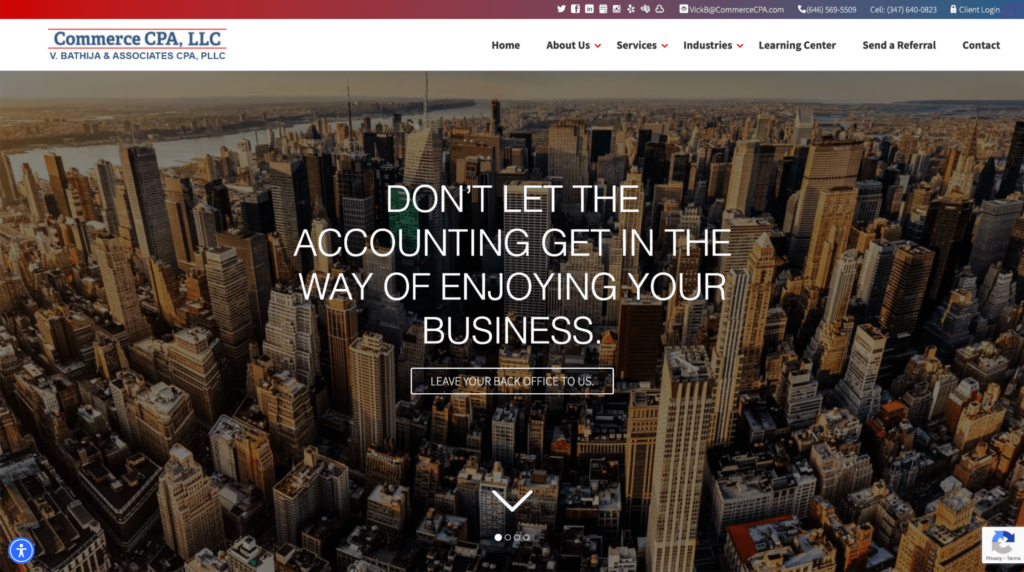 The panoramic view of the accountant’s city serves as a powerful symbol of how the firm serves customers throughout the city.We would, however, prefer that the text connect the image to the message. Something like, “No matter how large or small, companies throughout the city trust us with their business.”
The panoramic view of the accountant’s city serves as a powerful symbol of how the firm serves customers throughout the city.We would, however, prefer that the text connect the image to the message. Something like, “No matter how large or small, companies throughout the city trust us with their business.” - Davidson & Company
davidson-co.com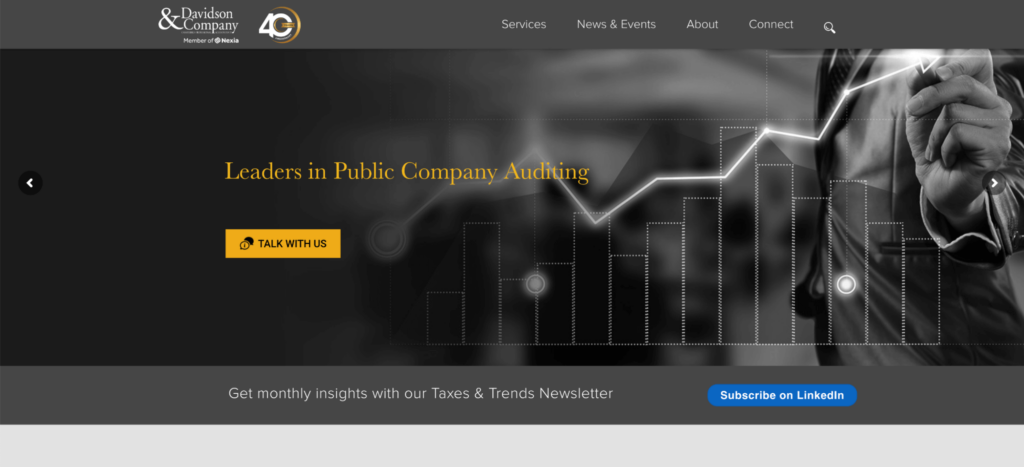 This accounting website example packs two powerful punches: a graph showing numbers on the rise and a human hand pointing the way. Images that include a human element drive conversions, studies show. And, who can resist seeing their money rise in value!Again, we would have liked to see some connection between the text itself and the image’s message.
This accounting website example packs two powerful punches: a graph showing numbers on the rise and a human hand pointing the way. Images that include a human element drive conversions, studies show. And, who can resist seeing their money rise in value!Again, we would have liked to see some connection between the text itself and the image’s message. - Goldfine & Company CPA PC
goldfinecpa.com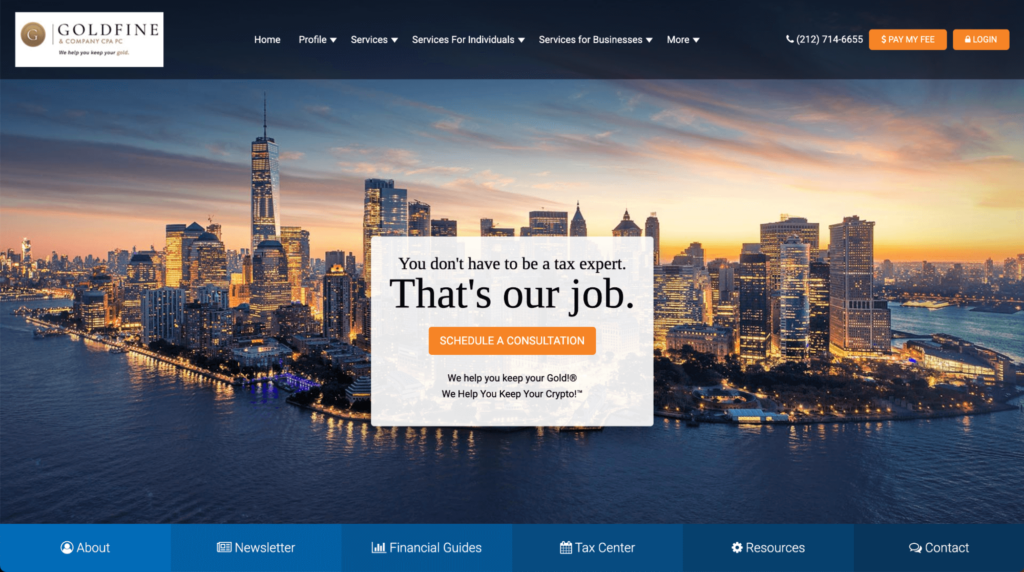 Stunning visuals of a city skyline link the idea of growth with this accounting firm’s results. In addition, the color blue figures prominently in the image. Blue, as studies show, increases trust — an essential for any accounting brand.
Stunning visuals of a city skyline link the idea of growth with this accounting firm’s results. In addition, the color blue figures prominently in the image. Blue, as studies show, increases trust — an essential for any accounting brand.
Great website menu design
- Baldwin and Associates, LLC
baldwincpa.com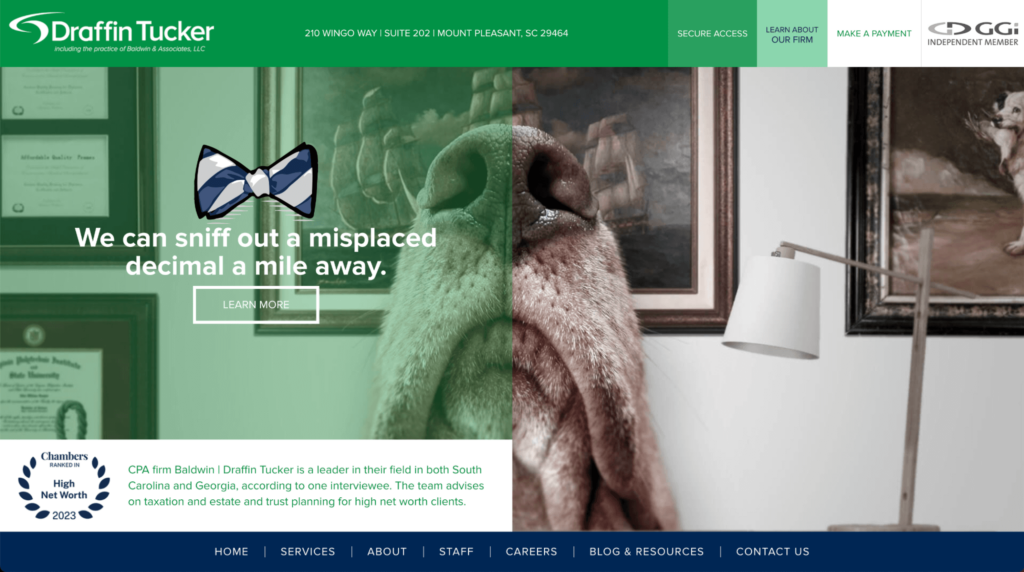 With its clear menu in all capital letters, this accounting website example makes it easy for customers and prospects to find the information they need quickly.And, as a bonus, their image and messaging assure customers that they’ll provide absolute accuracy in their work. Add in the color green for growth, and you have the perfect blend of visuals and text to catch their audience’s eye.
With its clear menu in all capital letters, this accounting website example makes it easy for customers and prospects to find the information they need quickly.And, as a bonus, their image and messaging assure customers that they’ll provide absolute accuracy in their work. Add in the color green for growth, and you have the perfect blend of visuals and text to catch their audience’s eye. - Andrews & Co.
andrews.ca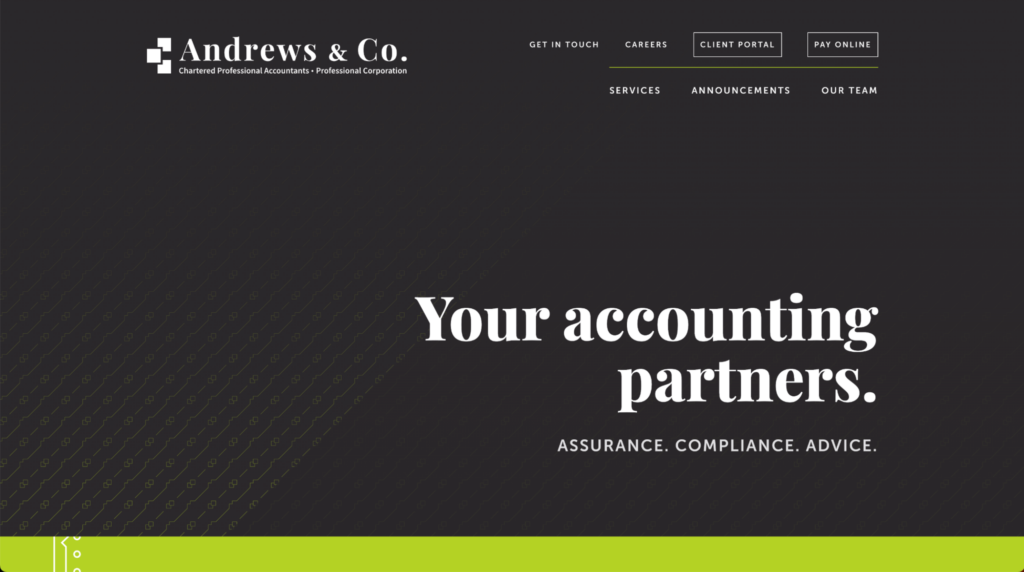 The first thing many users do after glancing at the image and text at the top of a web page is to head for the menu. Women are more likely to use the menu to look for information. Men, on the other hand, usually use a site’s search bar.This menu, with its bold, masculine look, will grab the attention of male as well as female prospects. And, the menu even includes a separate section for client access, set apart from the rest of the menu inside boxes.
The first thing many users do after glancing at the image and text at the top of a web page is to head for the menu. Women are more likely to use the menu to look for information. Men, on the other hand, usually use a site’s search bar.This menu, with its bold, masculine look, will grab the attention of male as well as female prospects. And, the menu even includes a separate section for client access, set apart from the rest of the menu inside boxes. - Cahill
cahillcpa.ca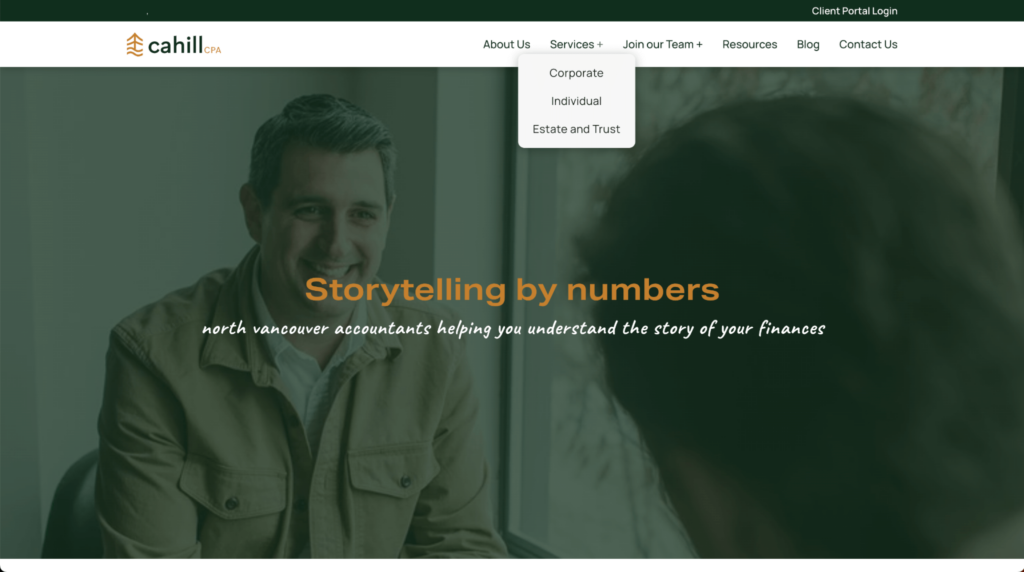 A drop-down menu displays the various services this accounting firm offers. What makes this menu a standout is the duplicate menu underneath the title, right on the main image. Having both options available at first glance ensures that prospects and customers can get to the page they need in seconds.
A drop-down menu displays the various services this accounting firm offers. What makes this menu a standout is the duplicate menu underneath the title, right on the main image. Having both options available at first glance ensures that prospects and customers can get to the page they need in seconds.
Engaging content
- ACCOTAX
accotax.ca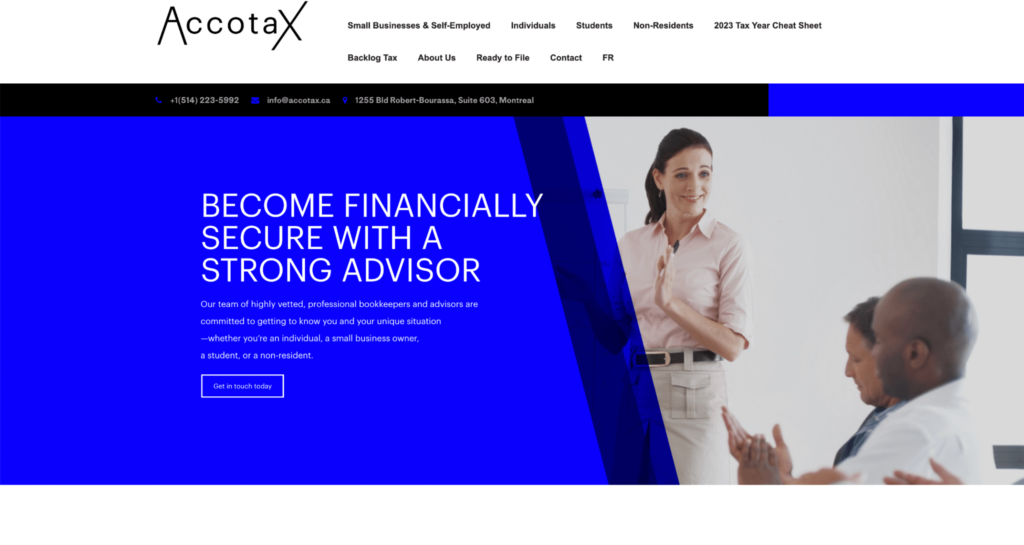 Who wouldn’t want “become financially secure with a strong advisor”? From the very start, this firm builds customer trust with engaging copy. Add their savvy use of the color blue and human imagery, and you have a complete picture of this accountant’s focus: the customer.
Who wouldn’t want “become financially secure with a strong advisor”? From the very start, this firm builds customer trust with engaging copy. Add their savvy use of the color blue and human imagery, and you have a complete picture of this accountant’s focus: the customer. - Grant Thornton
grantthornton.ca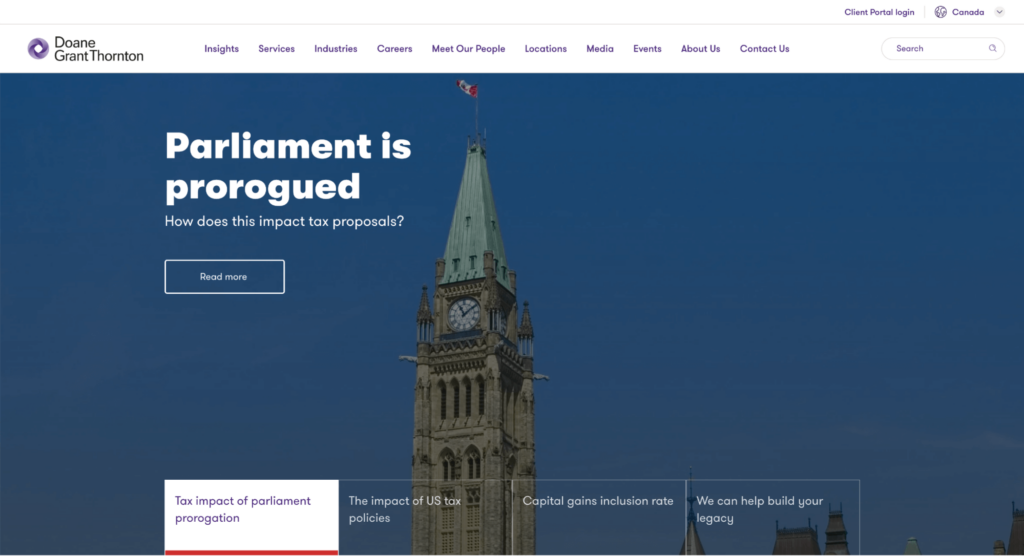 A perfect blend of content and imagery inspires prospective customers to solve their financial challenges with this accountant’s help. With its focus squarely on the customer and his business’s future, this content will drive conversions.An invitation to “read more” right below the title makes this message near-irresistible.
A perfect blend of content and imagery inspires prospective customers to solve their financial challenges with this accountant’s help. With its focus squarely on the customer and his business’s future, this content will drive conversions.An invitation to “read more” right below the title makes this message near-irresistible. - RHN CPA
rhncpa.com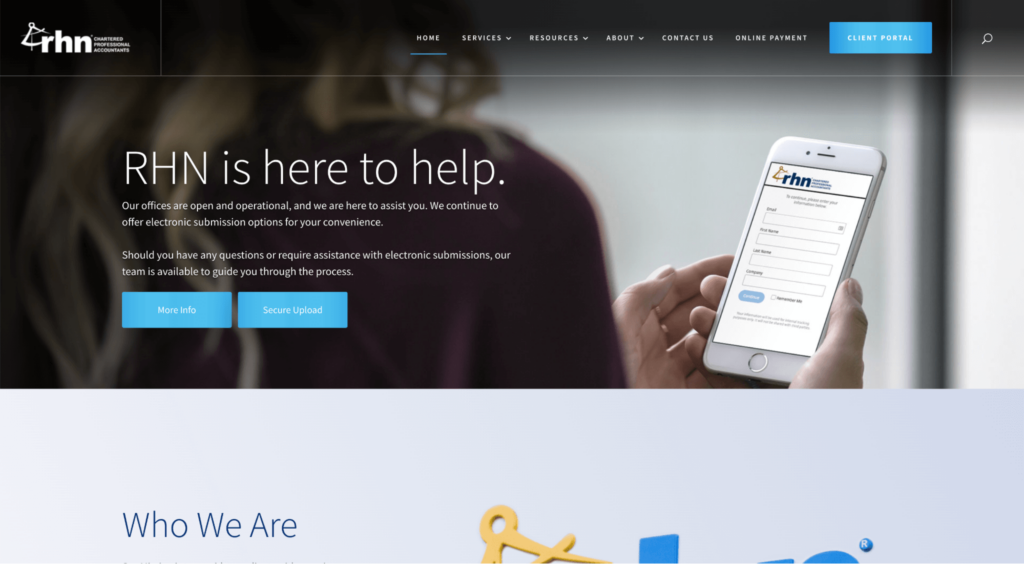 While the homepage content could use a little editing, this accounting firm’s services page is spot-on by organizing its industry-specific content with blocks of attractive images representing each industry. Its uncluttered look and multi-sensory message make it one of the finest services pages we have seen.
While the homepage content could use a little editing, this accounting firm’s services page is spot-on by organizing its industry-specific content with blocks of attractive images representing each industry. Its uncluttered look and multi-sensory message make it one of the finest services pages we have seen.
Nicely structured layout
- 212 Tax
212tax.com We love the use of the color blue on this website. With blocks of the color in key portions of the homepage, the layout exudes trust.
We love the use of the color blue on this website. With blocks of the color in key portions of the homepage, the layout exudes trust. - Triple M Professional Corp.
3maccounting.ca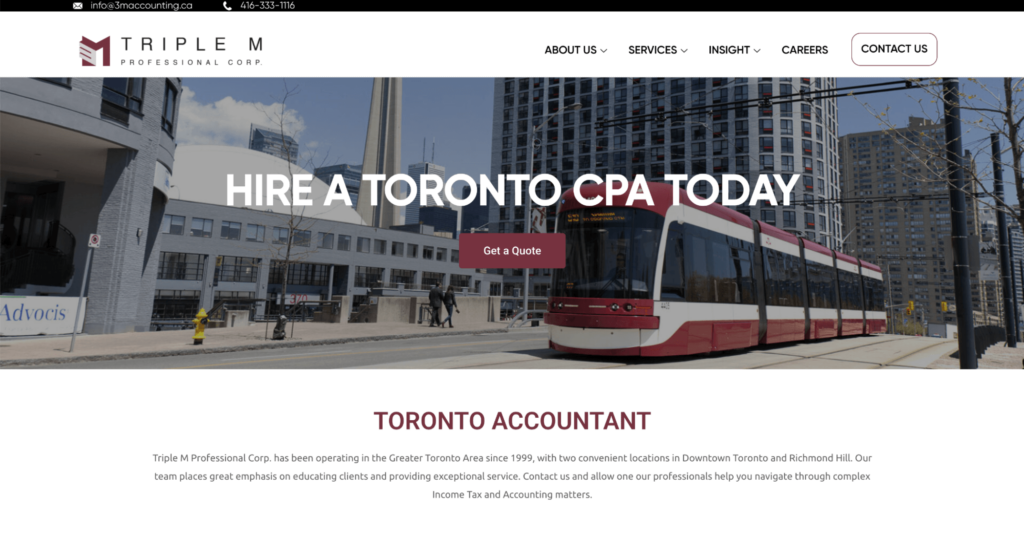 We love how this accounting website uses color to link its title to the image, using vivid burgundy to echo the tones of the train arriving at the company’s office. And, although the message underneath could use a good edit, the designer placed it squarely in the center, drawing the audience’s full attention.
We love how this accounting website uses color to link its title to the image, using vivid burgundy to echo the tones of the train arriving at the company’s office. And, although the message underneath could use a good edit, the designer placed it squarely in the center, drawing the audience’s full attention. - Tanner Accountants & Advisors
tannerco.com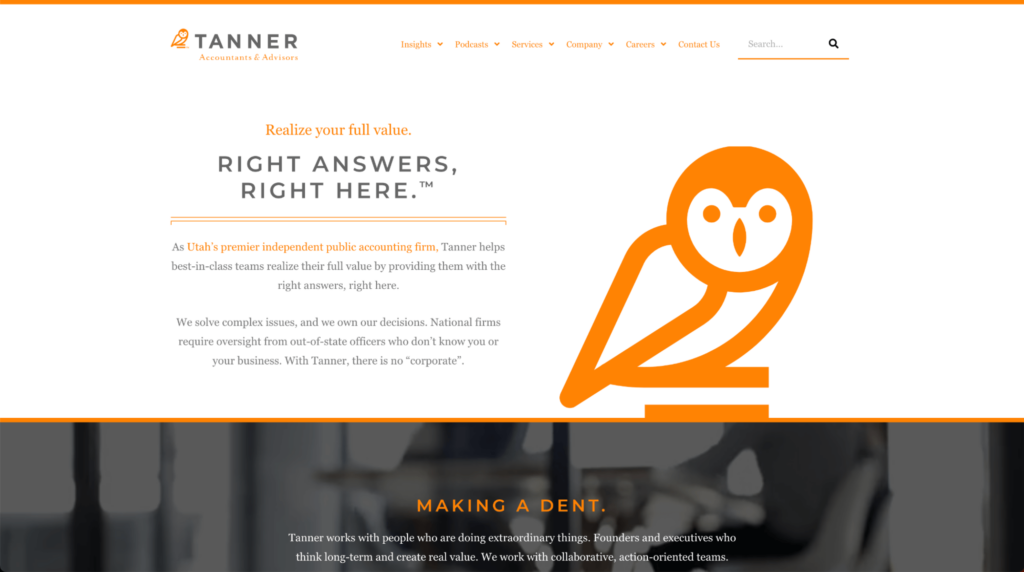 Tanner’s layout demonstrates excellence in blending design and text. From the wise owl imagery and shaded human silhouettes, this company demonstrates that it will truly bring its clients from dark into light with its expertise.Not only does it promise what it will do for its customers in its opening two paragraphs, but the text below shows exactly how it will fulfill that promise.
Tanner’s layout demonstrates excellence in blending design and text. From the wise owl imagery and shaded human silhouettes, this company demonstrates that it will truly bring its clients from dark into light with its expertise.Not only does it promise what it will do for its customers in its opening two paragraphs, but the text below shows exactly how it will fulfill that promise.
Typography in design
- Washington Society of Certified Public Accountants
wscpa.org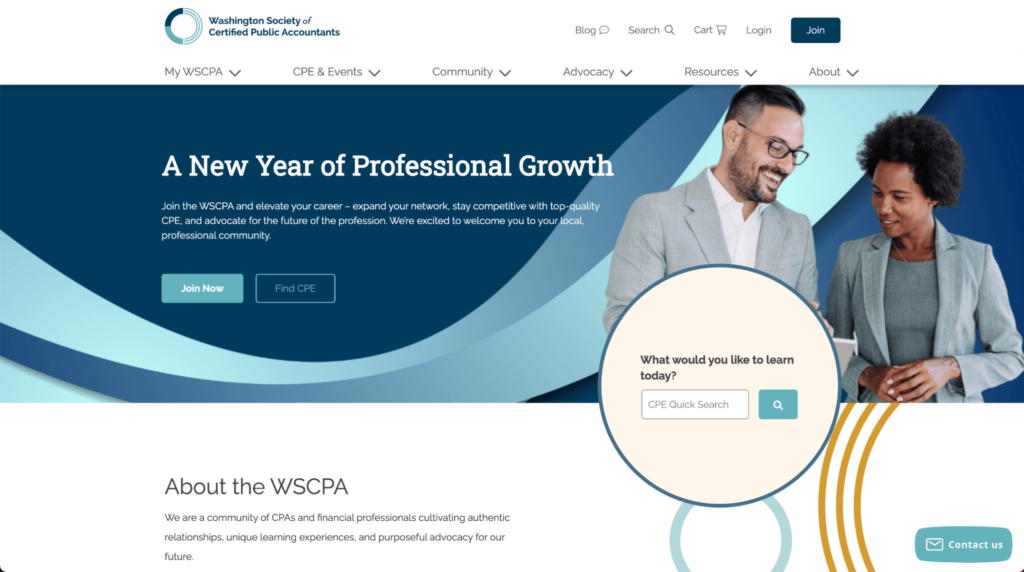 Instead of making the look of the font itself the central focus of accounting web design, you need to focus on making it readable. For blocks of text, a sans serif font works better for online readers. Sans serif type is as plain as fonts come, making it easy to read online.Get creative on the headings and subheadings, but use an easily readable sans serif font on the smaller text, as this accountants’ society did on theirs.
Instead of making the look of the font itself the central focus of accounting web design, you need to focus on making it readable. For blocks of text, a sans serif font works better for online readers. Sans serif type is as plain as fonts come, making it easy to read online.Get creative on the headings and subheadings, but use an easily readable sans serif font on the smaller text, as this accountants’ society did on theirs. - Positive Accounting
positiveaccounting.ca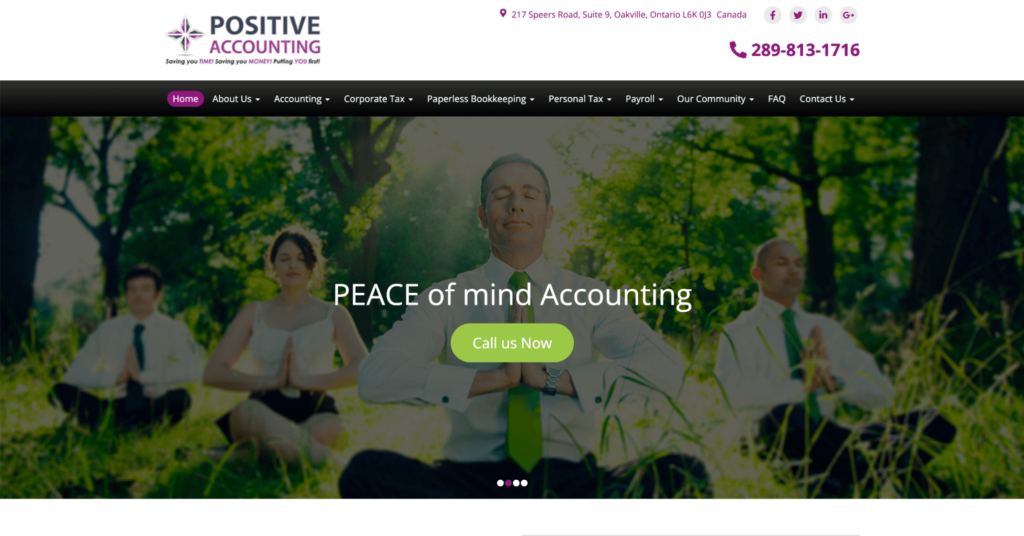 The easy-to-read type used in both the headings and main text gives this website’s typography a clean, seamless look. Using the same font in various sizes links each section with the other parts of the page.
The easy-to-read type used in both the headings and main text gives this website’s typography a clean, seamless look. Using the same font in various sizes links each section with the other parts of the page. - Maxwell, Locke & Ritter
mlrpc.com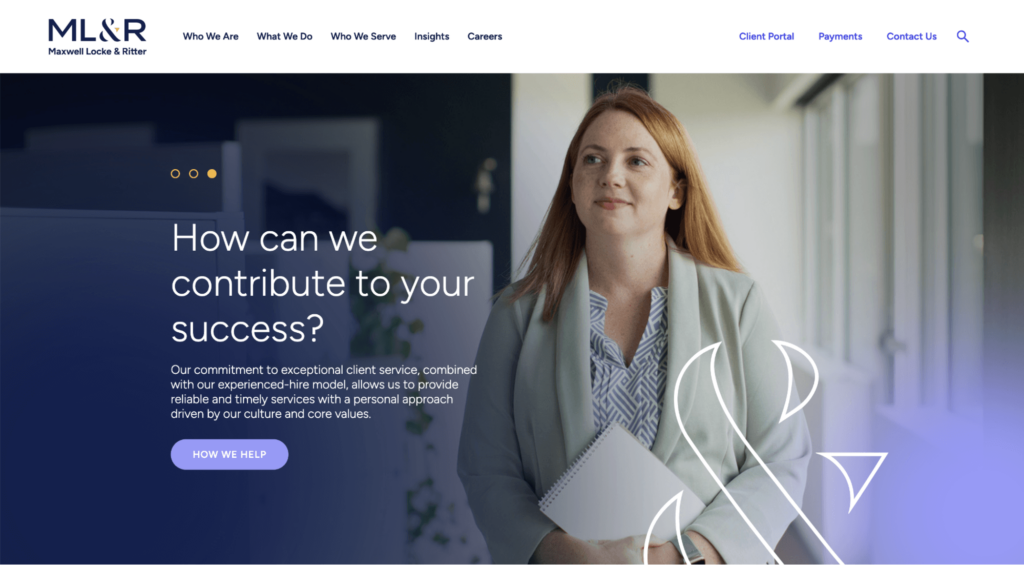 Clean, easy-to-read type pairs perfectly with this website’s outstanding use of white space. Easy on the eye and client-focused, this copy points users to the information they want to know.
Clean, easy-to-read type pairs perfectly with this website’s outstanding use of white space. Easy on the eye and client-focused, this copy points users to the information they want to know.
Bad accounting website design examples
- Is it a menu? Is it an expired URL?
 Better that they would have posted a “Under Construction” notice until they fleshed out their homepage.As is, this homepage looks exactly like an expired URL, giving prospects and clients every indication that they’re out of business. The only clue that it’s not a “URL for sale” page is that the arrows lead to actual web pages.
Better that they would have posted a “Under Construction” notice until they fleshed out their homepage.As is, this homepage looks exactly like an expired URL, giving prospects and clients every indication that they’re out of business. The only clue that it’s not a “URL for sale” page is that the arrows lead to actual web pages. - Word salad menu
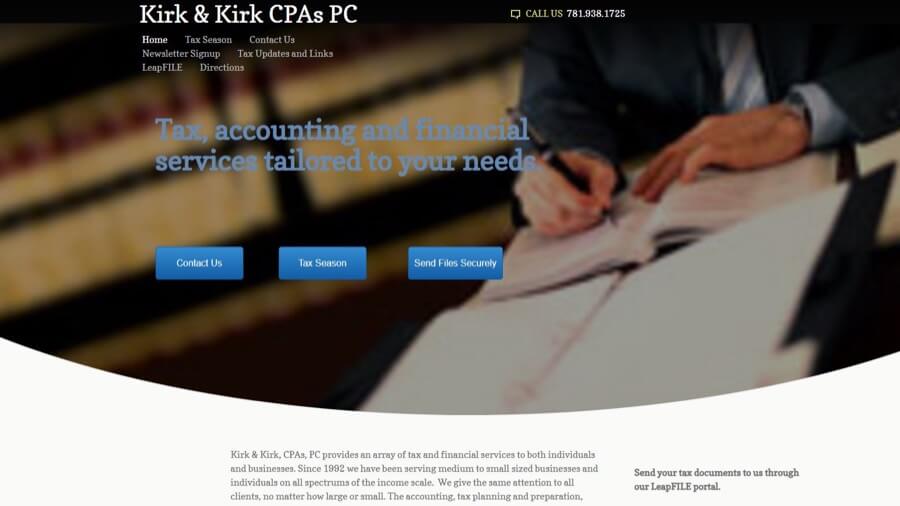 Instead of a row of neatly spaced categories, this website’s menu is a jumble of words hidden in the upper left-hand side, just under the firm’s name. And, they’re barely readable… Tiny white letters over a brown background make for strained eyes.Don’t ever scare off your prospects with such a menu! Take the time to do it right or hire professional website designers to create one your clients will love.
Instead of a row of neatly spaced categories, this website’s menu is a jumble of words hidden in the upper left-hand side, just under the firm’s name. And, they’re barely readable… Tiny white letters over a brown background make for strained eyes.Don’t ever scare off your prospects with such a menu! Take the time to do it right or hire professional website designers to create one your clients will love. - No imagery, unreadable company name, and missing accounting-related content
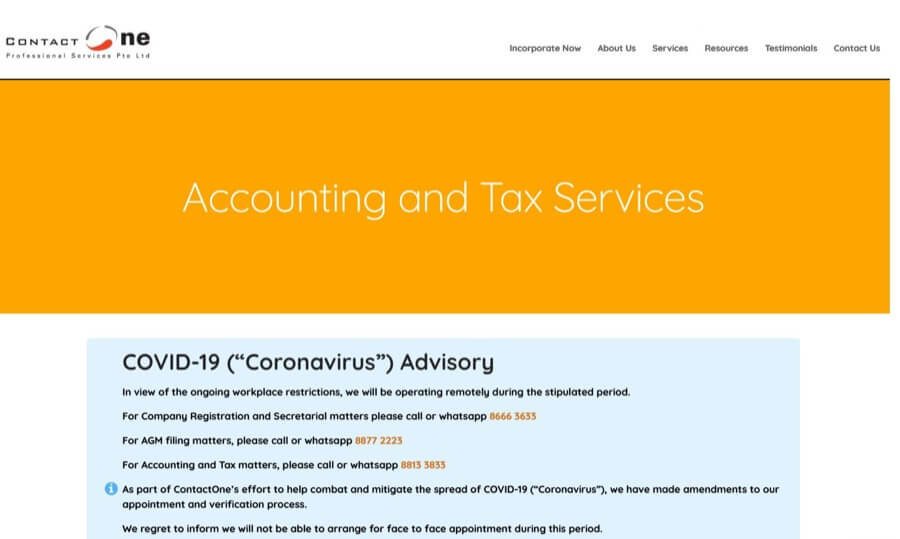 Don’t get us started. We’re sure they thought that incorporating their logo into their name at the top of the page would be cute. Trouble is, you can’t recognize that it’s an “O.” With no visuals and a bland headline, prospects will have little interest in reading on.But if they did, they wouldn’t find anything about accounting. Instead, the company listed its coronavirus protocols.Bad for SEO, bad for business. Just don’t…
Don’t get us started. We’re sure they thought that incorporating their logo into their name at the top of the page would be cute. Trouble is, you can’t recognize that it’s an “O.” With no visuals and a bland headline, prospects will have little interest in reading on.But if they did, they wouldn’t find anything about accounting. Instead, the company listed its coronavirus protocols.Bad for SEO, bad for business. Just don’t… - Keyword-stuffed title and no imagery
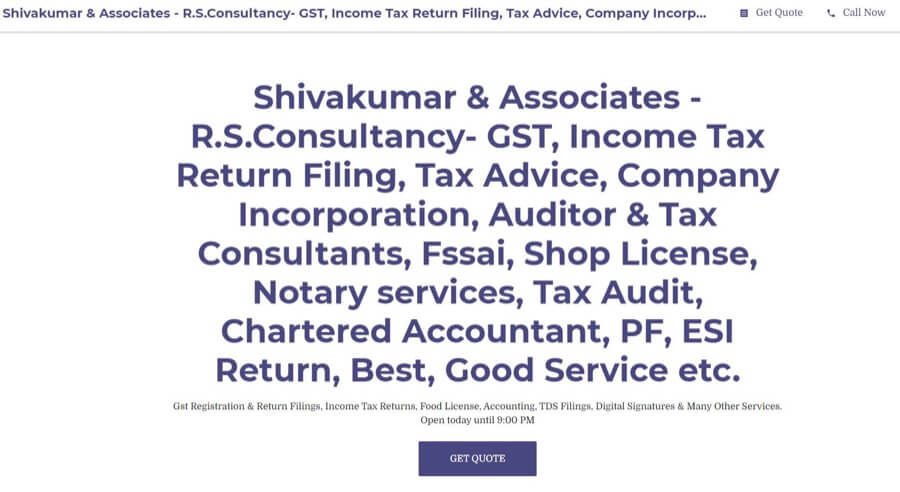 Can anyone say 2007? With its keyword-stuffed headline, this website might have survived back in the day. But today, such keyword stuffing will land you in hot water with Google and other search engines.And, what potential client would read on without an eye-catching visual and a customer-focused headline?Instead, tell a compelling story with both imagery and copy about what you can do for your clients.
Can anyone say 2007? With its keyword-stuffed headline, this website might have survived back in the day. But today, such keyword stuffing will land you in hot water with Google and other search engines.And, what potential client would read on without an eye-catching visual and a customer-focused headline?Instead, tell a compelling story with both imagery and copy about what you can do for your clients. - Who’s this website for, anyway?
 By looking at the most prominent imagery and text on this page, you would think that it’s Xero’s website. But it’s not. It’s a local accountant who partners with Xero, an accounting software provider.Instead, let your homepage serve as an advertisement about what your accounting firm can do for its clients. Mention your partnership with a national brand if you’d like, but don’t make it the main focus of your page.
By looking at the most prominent imagery and text on this page, you would think that it’s Xero’s website. But it’s not. It’s a local accountant who partners with Xero, an accounting software provider.Instead, let your homepage serve as an advertisement about what your accounting firm can do for its clients. Mention your partnership with a national brand if you’d like, but don’t make it the main focus of your page.
Don’t feel like building an amazing website alone?
Epiic designers can create your website for you.
Accounting website design checklist
It doesn’t matter whether you hire a design professional to redo your website or do it yourself. You need to learn about what makes a website work.
Learning how to create an accounting website will help you hire a better designer. And it will help a lot if you choose to go DIY. Here is a handy checklist to help you double-check your website for great design.
Studies show that color has a huge impact on people’s feelings. Colors that evoke trust or wealth are great choices for branding your accounting firm.
Use related colors that blend well with your main color for a seamless look. A color wheel can help you choose which colors blend best.
Here’s where we’d highly recommend hiring a design pro — even if you go DIY for the rest of the website design. Your logo says so much about your firm.
It’s often the first impression your clients will have of your brand. It sets the theme for your entire image.
Look at the logos from major brands: Nike, Coke, and Starbucks. They’re so iconic that they haven’t changed much down through the years. Aim for that kind of memorable when you create your logo.
For that reason, it’s important that you sit down with your designer to explain what your company stands for. Have a heart-to-heart talk about what problems you want to solve for your clients. With that information, your designer can create a logo that will say more than a thousand words.
Again, the images and text you choose for your website say a lot about your company. Original images that symbolize what your firm stands for, combined with catchy, client-focused text, are vital ingredients in setting the tone of your website.
A logical, intuitive layout, including your menu, is a critical aspect of helping users find what they need quickly. As you plan your layout, put yourself in a prospect’s shoes. What would they want to know about your company? In which order?
Having a designer helps during this part of the process. A designer can help you see your site from a user’s perspective.
Many companies, as you’ve seen from some of our examples, make the mistake of seeing the world from their own point of view. Instead of focusing on the client, their websites focus on themselves. An expert who is well-versed in both design and how users behave is worth their weight in gold.
Today’s audiences use a variety of browsers and devices to access the internet. Your website needs to have a seamless appearance no matter which browser or device your users are on.
Also, your website’s main elements need to work similarly across all devices and browsers. Let’s say a user is checking out your accounting website at the office and wants to continue browsing your site while she’s out at lunch.
If your site doesn’t work as it did on her desktop, she might feel frustrated and move on to another accountant’s site. Instead, take the time to test both appearance and function before you click “Publish.”
Users’ eyes (and brains) need some empty space to process the meaning of the graphics and text on your site. That space, called “white space,” needs to factor into your website’s design.
Too many amateur website owners try to cram as much information into a page as possible. A better idea is to link to more detailed information from clickable images with short descriptions.
Since 80 percent of marketers who use videos say that using them increases sales, videos are a must-have for 21st-century websites. Using videos also attracts more leads, according to 83 percent of marketers. It’s a no-brainer to include on your website, preferably on your homepage and services pages.
We’ve already spoken about the need to focus your content on meeting your prospects’ and current clients’ needs. That’s only the beginning.
It’s important to write clearly and concisely enough for readers to understand. You need to hook them with a catchy introduction and then keep them captive throughout the text. Use one theme that flows throughout your text for continuity.
Use images and infographics to break up the text and keep your readers’ attention. Finally, organize your content with headers, subheaders, or bullet points to guide your audience’s eyes. That’s especially important in longer pieces of content.
When you follow this checklist, creating a great accounting website design for your website will no longer be guesswork. Following these design best practices is as essential as following those in accounting.
Accounting website design FAQs
To create an accounting website, you need to focus on what you can do for your clients. Next, you need to pick a theme that ties into your firm’s culture and what sets you apart from others.
Also, you need to work those ideas into a design that attracts readers right from the start. Finally, you need to have content that makes it easy for people to read.
Accountants need to use website designs that give readers a sense of trust, of wealth. Although the design should have a professional tone, it should never bore its readers. Instead, use catchy copy and plenty of visuals to hold people’s attention until the end.
Accounting websites need to list the services the firm offers. They also need to set it apart from its competitors. Most importantly, it needs to show what it can do for its clients.
Gone are the days when a Facebook page or a phone book listing was enough to attract clients. Today, most people use the internet to search for accounting services.
A growing number of them use mobile devices to find an accountant. A website that they can find easily while they’re mobile is a must-have these days.
Thinking about refreshing your website or creating a new one for your accounting firm?
We’re here to help!
Jan 24, 2025




Andy Zenkevich
Andy is a seasoned CEO with years of hands-on experience in SEO, link building, content marketing and website development. His deep understanding of the digital landscape and passion for content marketing make him a trusted voice in the industry.